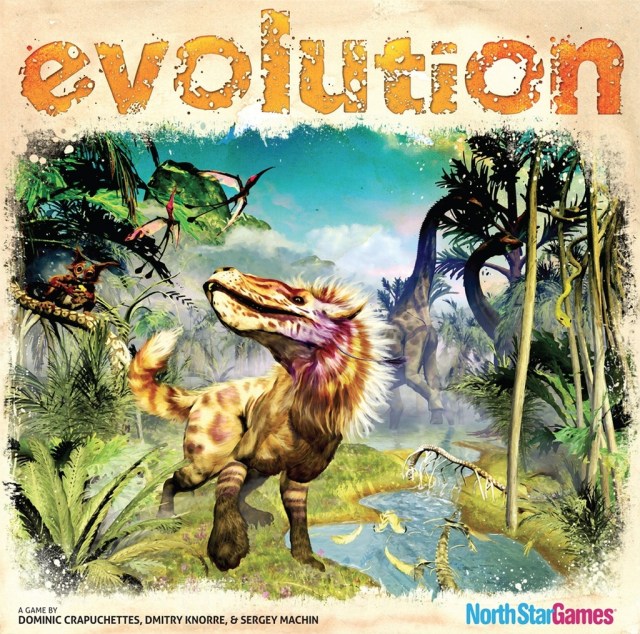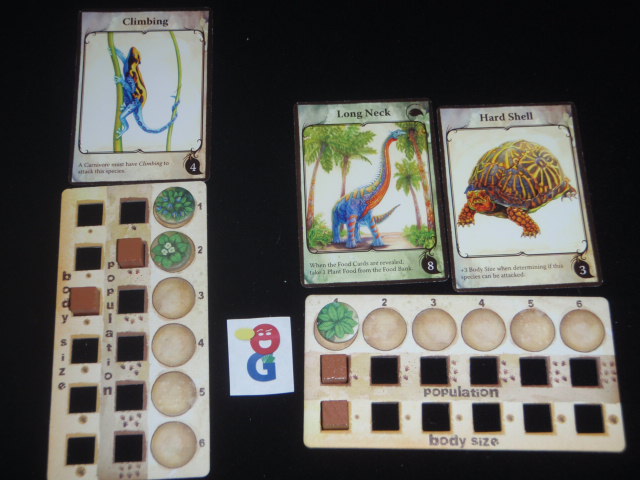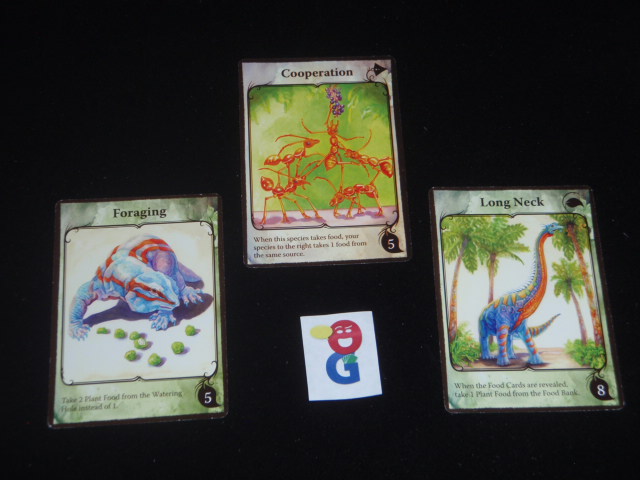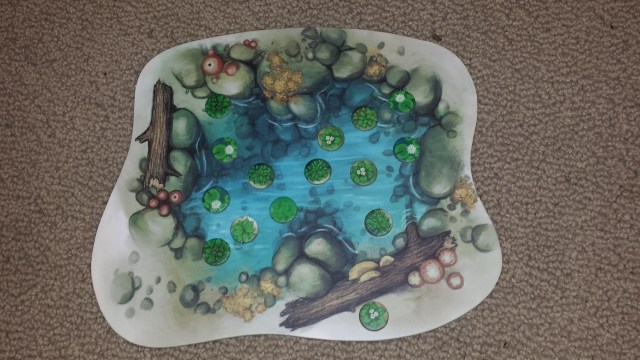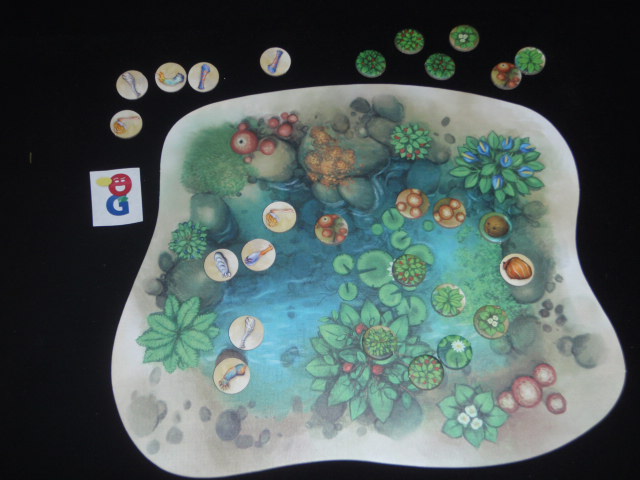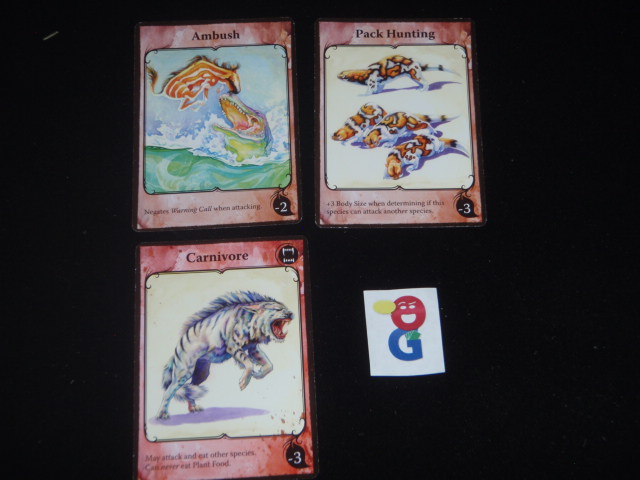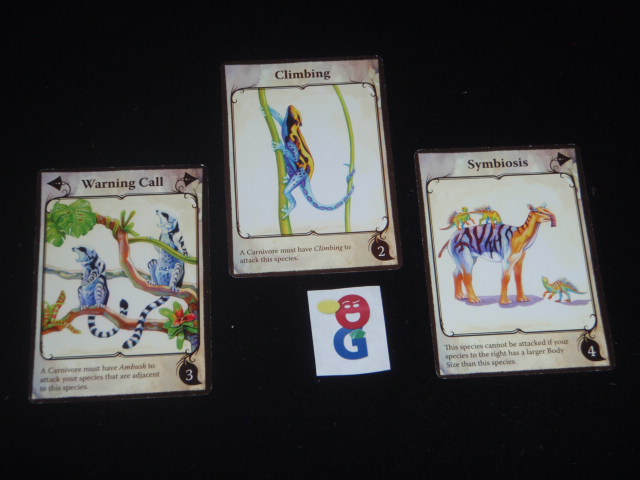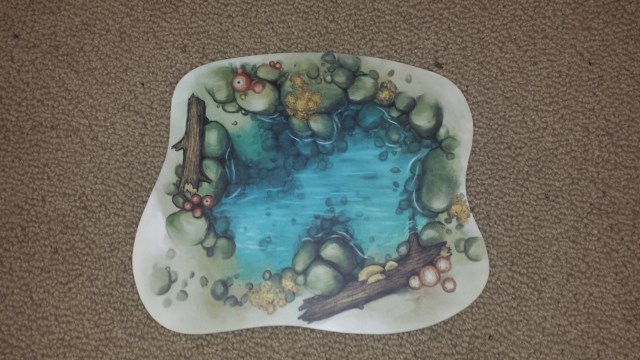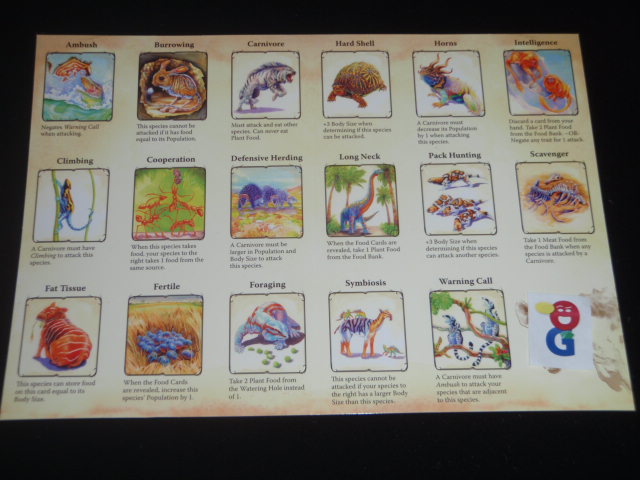Evolution, 2nd Ed. (2015)
- Designers: Dominic Crapuchettes, Dmitry Knorre, Sergey Machin
- Publisher: NorthStar Games
- Players: 2-6
- Ages: 10+
- Time: 60 minutes
- Times Played: 10, with review copy provided by NorthStar Games
My first review of Evolution was back in 2011 with the original Russian version of the game, published at that time by RightGames. The English rights going forward were purchased by NorthStar Games, and Dominic Crapuchettes has done a great job working with the game – kudos for him for that. There has been a lot of alteration done to the game – enough that I consider the 2014 version a different game entirely from its predecessor. My second review was published a few months ago. This third review is with an updated version of the game.
In Evolution, you are trying to create species and evolve them so that they survive and succeed. The game tries to emulate the ways in which real species change over time to adapt to the circumstances of their environment. The game is centered around the trait cards, there are 129 of these in the game. Each player starts with a single species, this is shown by a wooden species board. Each board has two tracks on it, one for body size and one for population. A new species starts with a marker in the 1 space on each track.
At the start of each round, players are always dealt three cards plus one additional card per species board they have in front of them. If the deck runs out of cards, the discards are shuffled so that everyone gets enough cards, but this also signifies that this will be the last round of the game.
Once players have received their cards, then each player chooses one card from their hand and places it facedown on the table to determine the Plant Food supply for this round. Each trait card has a Plant Food value in the lower right corner. You will use these cards in the Feeding Phase – but before that, you have to go through the Card Playing Phase.
Now, in clockwise order starting with the round’s Start Player, each player chooses to play as many trait cards as the want.
Trait cards can be played on existing species – cards played in this way are placed facedown above one of their species. There is a limit of only three traits per species. Further, you cannot play the same trait twice to a species.
Trait cards can be discarded to create a new species. A new wooden Species board is taken from the supply and placed either to the left or the right of the existing line of Species (thus, never between existing species). Wooden markers are placed on the “1” of both Body Size and Population.
Finally, trait cards can be discarded to increase the Body Size or Population value of any one species by 1. Both characteristics cannot be made larger than 6 – mostly because there aren’t holes on the Species board for larger numbers.
Players can play/discard as many cards as they want. Any unplayed cards remain in the player’s hand to be used later in the game. Once the Start plater hs finished playing all of his cards, then the next player in turn order gets to play/discard his cards. Once everyone has had a chance to play/discard, then all the facedown trait cards and flipped up.
Now it’s time for the feeding phase – all of the earlier played Plant Food cards are all revealed and the Plant Food total is summed. This number of Plant Food markers are placed on the Watering Hole mat. At this time, any players that have feeding traits (denoted by a leaf in the upper right corner) can be activated now. Once all of these early feeding traits have had a chance to be used, then it’s time for regular feeding.
Starting with the Start player, each player will in turn feed ONE of their hungry species – that is, any species which has fewer food tokens on its board than its Population. There are two types of species in the game – Carnivores and non-Carnivores, and each follows different feeding rules.
Non-Carnivores simply take food from the Plant Food pool. In general, a hungry species would take one Food token from the pool and place it on the lowest available circle above the population markers. You can never eat more food than your population. Some traits might affect the number of Food Tokens taken or may allow other neighboring species to also take a Food Token.
Carnivores prefer meat – in the form of other species. A Carnivore can attack any other species in the game, even one owned by the same player. A Carnivore must attack and eat as long as there is a species available to be munched upon. Attacks can be made as long as the Carnivore’s body size is greater than the species it is attacking AND there are no defensive traits on the smaller potential food source that prevent it from becoming a snack. If the attack is successful, the Carnivore takes tokens from the supply equal to the attacked species Body Size. Additionally, the attacked creature must reduce its Population by 1. If this value drops to 0, then that species is now extinct. The species board and trait cards are returned to the supply. The player who owned the now-extinct species does get a consolation – they draw a number of cards equal to the number of trait cards played on that species at the time of extinction.
The feeding phase continues on until either all species have eaten enough food to meet their population or all Hungry species no longer are able to eat. If a Species is still hunger at this point, its Population value is reduced to a number equal to the amount of food eaten. If it did not eat any food, it is now extinct – the board and traits are discarded, and the player draws new cards equal to the number of discarded traits. All players now take any Food tokens collected this round and place them in their scoring bag. If a player is left with no living species, he is given a new Species board from the supply to start with. Finally, the start player is passed to the left for the next Round.
Again, the end of the game is triggered in the Drawing Cards phase – the round in which the deck must be shuffled is the last round of the game. At the end of this final round, you calculate your scores. There are three ways to score points:
- One point per food token in your bag
- Points equal to the population levels of your existing species
- One point per trait card on each of your existing species
- If there is a tie on points, the player with the most Trait cards at the end of the game wins.
My thoughts on the game
First, in comparison to the original version, this new version plays much better from start to finish. Given my option to play either version, I would probably opt for the NorthStar version nine times out of ten. The biggest difference was the scoring: in the RightGames version, you scored one point per species and trait card on existing species at the end of the game. Nothing else mattered. This made for a game of 30-40 minutes of build up and hopefully getting lucky with the last round. Clearly, there is more going on in the start of the game in this newer version, and I find that a vast improvement. However, since most of your readers have likely not come across the RightGames version, I’ll restrict the rest of my comments to just the new game on its own merits.
Evolution is a well developed game aimed at the middle of the Eurogamer spectrum. I say this not in a denigrating way, but more as a reflection of the company, NorthStar Games. I have had a number of discussions over the years with Dom and Satish from NorthStar, and I know that they are trying to make games that are more accessible to the “masses”. Previous releases from the company such as Wits and Wagers have made the jump to mainstream distribution (i.e. being sold at Target). The company is still trying to appeal to more serious gamers as well – it appears that NorthStar is planning to start a series of tournaments to support the game. They also appear to be trying to get the game into the WBCs this year – though I am not sure of the outcome of this campaign yet.
The game blends hand-management skills and tactical timing of card plays. You need to constantly keep an eye on the competing species in the game to know which traits will be the most valuable to you at any given point in the game –and the relative value of traits will definitely change as the species in the game evolve.
You have to figure out how to best use your Trait cards each round. You could spend them all on a limited number of Species, trying to make them as strong and successful as possible. Or, you could use them to generate new Species – they might be fodder for the Carnivores in the game, but if they manage to survive, they will help you draw even more cards for the next round, and they might eventually be able to grow into strong and successful species on their own.
The trait cards feel well balanced, and there does not appear to be a single trait that simply overpowers the others. Depending on the other evolved species in the game, certain traits shine at certain times – just like in real life.
Another decision to be make is when (and if) to convert your species to Carnivore status. This is determined by playing a Carnivore trait card to a species. When you switch over, your new meat eater no longer has to rely upon the supply of Food Tokens at the Watering Hole, but it must now make sure that it can eat other things.
The art in the game is well done, and the graphics on the cards are especially good. A number of the cards appear to have been re-done with new art on the set I just received. My only beef with the graphic design from the first 2014 version is that it is sometimes difficult to pick out the Food Tokens on the Watering Hole mat. In our first games, we’ve decided just to dispense with the Watering Hole mat and place the tokens on the table itself, and this has solved the problem entirely. The new Watering Hole mat has a simpler design which makes it easier to pick out the food tokens.
The wood Species board add a nice touch and a bit of heft to the game. I’m not sure if they are more expensive than cardboard boards would have been, but in any event, they’re nice to hold and play with, so no real complaints there either way.
Overall, I would say that the amount of strategy in this game is in the middle of the spectrum or perhaps a bit on the lighter side – but again, this is what I would expect for a game that aspires for wider distribution. It’s still clearly more complicated than something a typical Monopoly player would want to play, but for those looking for a little bit more, this would be a good entry point to games that require more than rolling and moving. I’ve been pleasantly surprised by the depth of the game, and after ten games, I have not yet grown tired of it. My two boys have definitely enjoyed playing the game as well (which is part of the reason we were able to get to 10 plays!)
Thoughts from Other Opinionated Gamers (from the first 2014 version):
Greg Schloesser: This revised, updated edition of Evolution is certainly an improvement over its ancestor. In the original game, species appeared and perished quickly, as there was no mechanism to increase their population size. Get attacked once and the species vanished. Here, the world is a more stable place. Further, in the original, victory points were only earned on the last turn, so everything that happened previous to that was almost moot. The original game was much more chaotic, so these wild swings of fortune would have benefited from more frequent scoring opportunities. In this new version, players consistently earn points via the consumption of food and the survivability rate of species is significantly higher.
The component and artwork also represent a substantial improvement. The artwork is top notch, the species boards and counters are all sturdy and thick, and the cloth bags for storing consumed food are a touch of quality.
The mechanisms of the game work well and it is fun to play. However, it is not without problems. Food is simply too abundant. In the original version, the amount of food available each turn was determined by the roll of dice, which was admittedly quite random and resulted in large swings of fate for which it was impossible to plan. The revised method of each player placing one card to determine the food supply works in theory, but in practice often results in an overabundance of food. Unless one or more players has developed species that have alternative or more generous ways of feeding (which, if this happens, usually only occurs very late in the game), there is little if any incentive to place low-yielding cards into the food supply. All players want their species to survive, so everyone tends to toss in high-yielding cards. Building an array of carnivores will give a player an incentive to sabotage the food supply, but it is usually much more difficult to feed carnivores due to the defensive traits species can develop. Thus, carnivores are more risky to employ.
Another issue is that the game ends quickly. Just when it seems players are getting a nice mix of complementary traits, the deck expires. This happens far too quickly when playing with 5 or 6 players, so it appears the game is best suited for 3 or 4 participants. It certainly is a rare situation wherein a game actually plays quicker with more players. A larger deck, or simply going through the deck one more time will add some length to the game and allow things to evolve further.
NorthStar Games is certainly to be commended for taking an underdeveloped game that possessed some clever ideas and significantly improving it. The game is more balanced with far less wild swings of fortune. It is certainly one that most families could play, although the attack nature of the carnivores may cause some bruised feelings with younger children involved. Gamers will likely enjoy the game, but I fear they will encounter the same issues I discussed above. It might be nice to add a variant or two to help make food more scarce and to slightly lengthen the game. With these changes as options, you would have a game that would appeal to a variety of markets, which is always a good thing. Plus, true to its name and theme, we have a game that is ripe for expansions and could continue to evolve.
Mitchell Thomashow: This is one of the few newer games that I’ve had a chance to play. I’m particularly interested in games with an ecology and evolution theme, so I was delighted to have a chance to play this. However, I found the game disappointing. We tried the two player version six times. In our view, there just wasn’t enough variety in the game play, nor did it adequately simulate environmental variables. That would be OK, as the game’s didactics are ultimately less interesting to me than the gaming experience. However, Evolution seemed repetitive and dull. Perhaps it is more dynamic with multiple players. I agree with Greg that with some expansions and more interesting and various cards some of the issues he cites above can be mitigated.
Ratings from the Opinionated Gamers:
- I love it!
- I like it. Dale Y, Joe H, Craig M, John P
- Neutral. Luke H, Larry L, Greg S, Alan H, Jennifer G, Doug G, Mitchell T
- Not for me…


